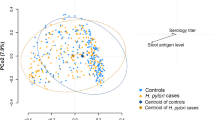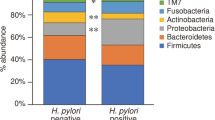Abstract
Helicobacter pylori infection is a prevalent global infection associated with several complications such as peptic ulcer, upper gastrointestinal bleeding, and stomach cancer. An imbalance in the gut microbiota composition or the relationship between the microbiota and the host may be implicated in the infection. To investigate this, we studied the intestinal microbiota of 50 newly infected adolescents with H. pylori compared with 50 age-matched and sex-matched healthy controls. The gut microbiota composition was assessed using real-time polymerase chain reaction (RT-PCR), and the fecal bacterial diversity and composition were compared between groups. Our findings revealed that Clostridium difficile and Salmonella spp. were significantly higher in the patient group compared to the control group. Additionally, lower counts of eubacteria, Bacteroides fragilis, Lactobacillus spp., Escherichia coli, and Methanobrevibacter smithii, were observed in the gut of adolescents with H. pylori. Conversely, adolescents with H. pylori infection had non-significantly higher counts of Bifidobacterium spp., C. difficile, and Salmonella spp. Multiple logistic regression analysis revealed that a greater abundance of Bifidobacterium spp. and Salmonella spp., a higher prevalence of C. difficile, and a lower abundance of Lactobacillus spp. were predictive of H. pylori infection. Overall, our results suggest that H. pylori infection is associated with changes in fecal microbiome composition.
Similar content being viewed by others
References
Alverdy JC, Hyoju SK, Weigerinck M, et al. 2017 The gut microbiome and the mechanism of surgical infection. Br. J. Surg. 104 e14–e23
Atherton JC 2006 The pathogenesis of Helicobacter pylori-induced gastro-duodenal diseases. Annu. Rev. Pathol. 1 63–96
Benavides-Ward1 A, Vasquez-Achaya F, Silva-Caso W, et al. 2018 Helicobacter pylori and its relationship with variations of gut microbiota in asymptomatic children between 6 and 12 years. BMC Res. Notes 11 468
Bermejo F, Boixeda D, Gisbert JP, et al. 2002 Rapid urease test utility for Helicobacter pylori infection diagnosis in gastric ulcer disease. Hepatogastroenterology 49 572–575
Bontems P, Aksoy E, Burette A, et al. 2014 NF-κB activation and severity of gastritis in Helicobacter pylori-infected children and adults. Helicobacter 19 157–167
Brawner KM, Kumar R, Serrano CA, et al. 2017 Helicobacter pylori infection is associated with an altered gastric microbiota in children. Mucosal Immunol. 10 1169–1177
Bühling A, Radun D, Müller WA, et al. 2001 Influence of anti-Helicobacter triple-therapy with metronidazole, omeprazole, and clarithromycin on intestinal microflora. Aliment. Pharmacol. Ther. 15 1445–1452
Castano-Rodrıguez N, Kaakoush NO, Lee WS, et al. 2017 Dual role of Helicobacter and Campylobacter species in IBD: a systematic review and meta-analysis. Gut 66 235–249
Chen L, Xu W, Lee A, et al. 2018 The impact of Helicobacter pylori infection, eradication therapy and probiotic supplementation on gut microenvironment homeostasis: an open-label, randomized clinical trial. EBioMedicine 235 87–96
Cremer J, Arnoldini M and Hwa T 2017 Effect of water flow and chemical environment on microbiota growth and composition in the human colon. Proc. Natl. Acad. Sci. USA 114 6438–6443
Franceschi F, Zuccalà G, Roccarina D, et al. 2014 Clinical effects of Helicobacter pylori outside the stomach. Nat. Rev. Gastroenterol. Hepatol. 11 234–242
Frost F, Kacprowski T, Rühlemann M, et al. 2019 Helicobacter pylori infection associates with fecal microbiota composition and diversity. Sci. Rep. 9 20100
Gao J-J, Zhang Y, Gerhard M, et al. 2018 Association between gut microbiota and Helicobacter pylori-related gastric lesions in a high-risk population of gastric cancer. Front. Cell Infect. Microbiol. 8 202
Gorkiewicz G and Moschen A 2018 Gut microbiome: a new player in gastrointestinal disease. Virchows Arch. 472 159–172
Heimesaat MM, Fischer A, Plickert R, et al. 2014 Helicobacter pylori induced gastric immunopathology is associated with distinct microbiota changes in the large intestines of long-term infected Mongolian gerbils. PLoS One 9 e100362
Hooi JKY, Lai WY, Ng WK, et al. 2017 Global prevalence of Helicobacter pylori infection: systematic review and meta-analysis. Gastroenterology 153 420–429
Kadhim G, Shikh M, Omar H, et al. 2018 Vitamin B12 deficiency in Helicobacter pylori infected patients. OALib. 5 https://doi.org/10.4236/oalib.1104172
Kienesberger S, Cox LM, Livanos A, et al. 2016 Gastric Helicobacter pylori infection affects local and distant microbial populations and host responses. Cell Rep. 14 1395–1407
Koletzko S, Jones NL, Goodman KJ, et al. 2011 Evidence-based guidelines from ESPGHAN and NASPGHAN for Helicobacter pylori infection in children. J. Pediatr. Gastroenterol. Nutr. 53 230–243
Li S, Huang XL, Sui JZ, et al. 2014 Meta-analysis of randomized controlled trials on the efficacy of probiotics in Helicobacter pylori eradication therapy in children. Eur. J. Pediatr. 173 153–161
Mello CS, Rodrigues MS, Filho HB, et al. 2018 Fecal microbiota analysis of children with small intestinal bacterial overgrowth among residents of an urban slum in Brazil. J. Pediatr. 94 483–490
Ménard A, Santos A, Mégraud F, et al. 2002 PCR-restriction fragment length polymorphism can also detect point mutation A2142C in the 23S rRNA gene, associated with Helicobacter pylori resistance to clarithromycin. Antimicrob. Agents Chemother. 46 1156–1157
Myllyluoma E, Ahlroos T, Veijola L, et al. 2007 Korpela R. Effects of anti-Helicobacter pylori treatment and probiotic supplementation on intestinal microbiota. Int. J. Antimicrob. Agents 29 66–72
Oertli M, Sundquist M, Hitzler I, et al. 2012 DC-derived IL-18 drives Treg differentiation, murine Helicobacter pylori-specific immune tolerance, and asthma protection. J. Clin. Invest. 122 1082–1096
O’Ryan ML, Lucero Y, Rabello M, et al. 2015 Persistent and transient Helicobacter pylori infections in early childhood. Clin. Infect. Dis. 61 211–218
Perlmutter D 2015 Brain maker: the power of gut microbes to heal and protect your brain–for life (Boston: Little, Brown and Company)
Schulz C, Schütte K, Koch N, et al. 2018 The active bacterial assemblages of the upper GI tract in individuals with and without Helicobacter infection. Gut 67 216–225
Shuval-Sudai O and Granot E 2003 An association between Helicobacter pylori infection and serum vitamin B12 levels in healthy adults. J. Clin. Gastroenterol. 36 130–133
Szajewska H, Horvath A and Piwowarczyk A 2010 Meta-analysis: the effects of Saccharomyces boulardii supplementation on Helicobacter pylori eradication rates and side effects during treatment. Aliment. Pharmacol. Ther. 32 1069–1079
Tamura A, Fujioka T and Nasu M 2002 Relation of Helicobacter pylori infection to plasma vitamin B12, folic acid, and homocysteine levels in patients who underwent diagnostic coronary arteriography. Am. J. Gastroenterol. 97 861–866
Verma R, Verma AK, Ahuja V, et al. 2010 Real-time analysis of mucosal flora in patients with inflammatory bowel disease in India. J. Clin. Microbiol. 48 4279–4282
Zabala Torrres B, Lucero Y, Lagomarcino AJ, et al. 2017 Review: Prevalence and dynamics of Helicobacter pylori infection during childhood. Helicobacter 22 e12399
Funding
None to declare.
Author information
Authors and Affiliations
Corresponding author
Additional information
Corresponding editor: Dipshikha Chakravortty
Rights and permissions
About this article
Cite this article
Amrousy, D.E., Ashry, H.E., Maher, S. et al. Helicobacter pylori infection and gut microbiota in adolescents: Is there a relation?. J Biosci 49, 7 (2024). https://doi.org/10.1007/s12038-023-00387-7
Received:
Accepted:
Published:
DOI: https://doi.org/10.1007/s12038-023-00387-7




